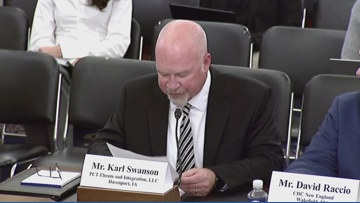Report on Educational Governance and Sustainable Development Goals in Orange County, California
Case Study: Orange Unified School District (OUSD)
This report analyzes recent events within the Orange Unified School District (OUSD) in California, focusing on the tenure and subsequent recall of board member Madison Miner. The case highlights significant tensions and challenges in aligning local educational policies with key United Nations Sustainable Development Goals (SDGs), particularly SDG 4 (Quality Education), SDG 5 (Gender Equality), SDG 10 (Reduced Inequalities), and SDG 16 (Peace, Justice and Strong Institutions).
Analysis of Policy Initiatives in Relation to SDG 4: Quality Education
Madison Miner’s election to the OUSD board was predicated on concerns directly related to the principles of SDG 4: Quality Education, which aims to ensure inclusive and equitable quality education for all. Her platform addressed perceived shortcomings in the district’s ability to serve vulnerable student populations.
Focus on Inclusive and Equitable Education
- English-Language Learners: A primary motivation for Miner’s candidacy was the treatment of English-language learners. Citing data that 90% of such students in Orange County do not achieve English proficiency annually, her efforts sought to address a critical gap in equitable educational outcomes, a core target of SDG 4. California’s statewide data indicates 19% of students are English-language learners, underscoring the scale of this challenge.
- Students with Disabilities: Miner expressed frustration with the lack of appropriate testing materials for students with disabilities, indicating a failure to provide an inclusive learning environment tailored to diverse needs, as mandated by SDG 4.
Curriculum Transparency and Institutional Accountability
A policy was enacted requiring teachers to make all instructional materials publicly accessible online. This initiative can be viewed as an attempt to enhance institutional transparency and parental engagement, which are foundational to building the accountable institutions called for in SDG 16.
Challenges to SDG 5 (Gender Equality) and SDG 10 (Reduced Inequalities)
Several policies enacted during Miner’s tenure generated significant controversy, creating a direct conflict with the objectives of SDG 5: Gender Equality and SDG 10: Reduced Inequalities. These goals advocate for the elimination of discrimination and the empowerment and inclusion of all individuals, irrespective of gender identity or other status.
Policies on Gender Identity
- Parental Notification: The board passed a provision requiring schools to notify parents if a student requests to use a different name, pronoun, or gender-segregated facility. While proponents framed this as a parental right, opponents argued it contravened the principles of SDG 5 and SDG 10 by potentially endangering LGBTQ+ students in unsupportive homes and undermining their right to self-identification.
- State-Level Intervention: The California state legislature subsequently passed AB-1955, which explicitly bans school districts from mandating the disclosure of a student’s gender identity, prioritizing student safety and inclusion in alignment with SDG 5 and SDG 10.
Policies on Representation and Access to Information
- Banning of Pride Flag: The board banned the flying of the LGBTQ+ Pride flag on school property, a move critics argue signals a lack of institutional support for LGBTQ+ individuals, contrary to the inclusive spirit of SDG 10.
- Suspension of Digital Library: The district’s digital library was temporarily suspended over concerns about “age-inappropriate books.” Organizations like PEN America note that such book-banning efforts disproportionately target materials featuring LGBTQ+ characters and characters of color, thereby exacerbating inequalities and working against the aims of SDG 10.
Institutional Integrity and Social Cohesion under SDG 16
The events in OUSD serve as a case study for the challenges to SDG 16: Peace, Justice and Strong Institutions, which seeks to promote peaceful, inclusive societies and build effective, accountable institutions at all levels.
Political Polarization and Democratic Accountability
- The intense political conflict culminated in a recall election on April 2, 2024, where Miner was removed from the board with 53.4% of the vote. This recall demonstrates a mechanism for public accountability, a key component of SDG 16.7, which calls for responsive, inclusive, and representative decision-making.
- However, the process was marked by severe social friction. Miner reported receiving threats and public harassment, indicating a breakdown in peaceful civic discourse, which undermines the goal of fostering peaceful and inclusive societies (SDG 16.1).
Conclusion
The policy debates and political outcomes within the Orange Unified School District illustrate the complex interplay between different Sustainable Development Goals. Efforts to improve aspects of SDG 4 (Quality Education) for certain groups were perceived as undermining progress on SDG 5 (Gender Equality) and SDG 10 (Reduced Inequalities) for others. The resulting conflict tested the resilience of democratic processes and highlighted the profound challenges in building the peaceful, just, and strong institutions envisioned by SDG 16.
Analysis of the Article in Relation to Sustainable Development Goals
1. Which SDGs are addressed or connected to the issues highlighted in the article?
The article discusses several issues that connect to four primary Sustainable Development Goals (SDGs). These goals are concerned with education, equality, and the nature of governance and societal peace.
- SDG 4: Quality Education: The core of the article revolves around the quality of education in California’s public schools, specifically the Orange Unified School District (OUSD). It highlights concerns about educational standards, curriculum content, and support for vulnerable student groups.
- SDG 10: Reduced Inequalities: The article delves into policies and debates that directly impact inequalities among different student groups. This includes the treatment of English-language learners, students with disabilities, and LGBTQ+ students, as well as the disproportionate effect of book bans on characters of color.
- SDG 16: Peace, Justice and Strong Institutions: The political conflict described in the article, including threats of violence against a public official, a contentious recall election, and debates over the transparency and accountability of the school board, directly relates to the goal of building peaceful, just, and effective institutions.
- SDG 5: Gender Equality: The debate surrounding policies on students’ gender identity, such as parental notification for using different pronouns and access to facilities like bathrooms, connects to the broader principles of SDG 5, which aims to end all forms of discrimination, including those based on gender identity.
2. What specific targets under those SDGs can be identified based on the article’s content?
Based on the issues discussed, several specific SDG targets can be identified:
SDG 4: Quality Education
- Target 4.1: “By 2030, ensure that all girls and boys complete free, equitable and quality primary and secondary education…” The article’s reference to California ranking 38th in K-12 education points to a concern about the overall quality of education being provided.
- Target 4.5: “By 2030, eliminate gender disparities in education and ensure equal access to all levels of education and vocational training for the vulnerable, including persons with disabilities… and children in vulnerable situations.” This is directly addressed by Miner’s stated motivation for running for the school board, citing her frustration with how the “California education system treats English-language learners and children with disabilities.”
- Target 4.a: “Build and upgrade education facilities that are child, disability and gender sensitive and provide safe, non-violent, inclusive and effective learning environments for all.” The controversy over parental notification policies, bathroom access for transgender students, and the banning of the pride flag are all related to the challenge of creating a gender-sensitive and inclusive learning environment.
SDG 10: Reduced Inequalities
- Target 10.2: “By 2030, empower and promote the social, economic and political inclusion of all, irrespective of age, sex, disability, race, ethnicity, origin, religion or economic or other status.” The debate over policies affecting LGBTQ+ students and the mention by critics that book bans “disproportionately” target stories with “LGBTQ+ characters and characters of color” directly relate to the social inclusion of these groups within the educational system.
- Target 10.3: “Ensure equal opportunity and reduce inequalities of outcome, including by eliminating discriminatory laws, policies and practices…” The conflict between the school district’s parental notification policy and the state-level AB-1955, which bans such policies, is a clear example of a struggle over a potentially discriminatory practice.
SDG 16: Peace, Justice and Strong Institutions
- Target 16.1: “Significantly reduce all forms of violence and related death rates everywhere.” This target is relevant due to the personal threats Miner faced. The article states, “Miner also said her life and her four kids’ lives have been threatened on social media” and that she has been “followed home,” highlighting a breakdown in peaceful civil discourse.
- Target 16.6: “Develop effective, accountable and transparent institutions at all levels.” The entire narrative focuses on the functioning of a local government institution—the OUSD board. Miner’s policy requiring teachers to upload instructional materials for public access was an attempt to increase transparency. Her subsequent recall by voters (53.4% in favor) is a direct mechanism of public accountability.
- Target 16.7: “Ensure responsive, inclusive, participatory and representative decision-making at all levels.” The article showcases the participatory nature of local democracy through Miner’s election and subsequent recall. However, the deep divisions and accusations from both sides suggest a failure to achieve inclusive and responsive decision-making that satisfies the entire community.
3. Are there any indicators mentioned or implied in the article that can be used to measure progress towards the identified targets?
The article provides several quantitative and qualitative data points that can serve as indicators for measuring progress.
Indicators for SDG 4 (Quality Education)
- Proportion of students who are English-language learners: The article states, “Per the California Department of Education, 19 percent of students are English-language learners.”
- Rate of English language proficiency acquisition: Miner’s research found that “90 percent of English-language learners in Orange County do not gain English proficiency status each year,” serving as a direct performance indicator.
- National education ranking: The article notes that California “ranks 38th in K-12 education” according to the U.S. News & World Report, which is a comparative indicator of educational quality.
Indicators for SDG 10 (Reduced Inequalities)
- Existence of potentially discriminatory policies: The implementation of a “transgender parental notification policy” and its subsequent banning by state law (AB-1955) serve as indicators of policy-level conflicts over discrimination.
- Disproportionate impact of content restriction: The claim that banned books “‘disproportionately’ include stories with LGBTQ+ characters and characters of color” implies an indicator related to the content of censored materials.
Indicators for SDG 16 (Peace, Justice and Strong Institutions)
- Incidence of threats against public officials: While not quantified, the article’s report that Miner “has been ‘cussed out’ at grocery stores,” “followed home,” and received death threats on social media is a qualitative indicator of violence and a lack of safety for those in public service.
- Voter participation and outcomes in elections: The article provides specific election data, such as Miner winning her seat by 221 votes and being recalled with “53.4 percent voting in favor,” which are direct indicators of public participation and institutional accountability.
4. Table of SDGs, Targets, and Indicators
| SDGs | Targets | Indicators Identified in the Article |
|---|---|---|
| SDG 4: Quality Education |
4.1: Ensure quality primary and secondary education.
4.5: Ensure equal access for the vulnerable, including persons with disabilities and English-language learners. 4.a: Provide safe, inclusive, and effective learning environments. |
– California’s rank in K-12 education (38th). – Percentage of students who are English-language learners (19%). – Annual rate of English-language learners not achieving proficiency (90%). – Lack of appropriate test materials for students with disabilities. – Existence of policies on pride flags and gender identity. |
| SDG 10: Reduced Inequalities |
10.2: Promote social and political inclusion of all.
10.3: Ensure equal opportunity and eliminate discriminatory policies. |
– Implementation of a “transgender parental notification policy.” – Enactment of state law (AB-1955) to ban such policies. – Reports that book bans disproportionately affect stories with LGBTQ+ characters and characters of color. |
| SDG 16: Peace, Justice and Strong Institutions |
16.1: Reduce all forms of violence.
16.6: Develop effective, accountable, and transparent institutions. 16.7: Ensure responsive, inclusive, and participatory decision-making. |
– Reported death threats and harassment against a school board member. – Implementation of a policy for public access to curriculum materials. – Election results for school board seat (won by 221 votes). – Outcome of recall election (53.4% in favor of recall). |
Source: thefulcrum.us







